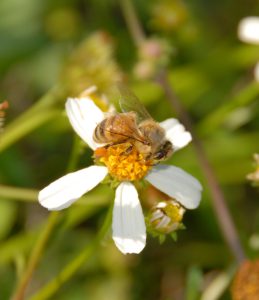
It is likely impossible to walk out into a landscape and not see this plant. Although the bane of gardeners as a successful weed, this plant is also a friend of pollinators and butterflies, and the larval host plant of a certain butterfly. You may also know this plant when it detaches its seeds onto your clothing or pet’s fur. That’s right, its Bidens alba!
While Bidens alba has many common names, let’s just call it Bidens. Surprisingly, this somewhat weedy plant is a native found all over Florida. Its success as an annual/short-lived perennial makes it a weed in landscapes growing up to three feet tall. The barbed seeds easily attach to passersby and get transported all over to easily germinate and start another colony of Bidens. Fun fact – each Bidens plant has the capacity to produce three thousand to six-thousand seeds! Able to adapt to many habitats, Bidens is also very drought-tolerant once established. The seedlings grow almost unnoticed amongst other weeds or landscape plants and even in lawns. Young Bidens plants can be easily removed mechanically by hand-picking or hoeing. Mulch will also help suppress this weed. Once established, Bidens is a bit tenacious and will take some extra effort to extract. Like many unwanted plants, you can win a battle on removing Bidens, but you cannot win the war – they will return. Monitoring is required to find this weed and remove small populations before they get out of hand.
Now on the flip side, Bidens may be tolerated or encouraged in ungroomed areas where this native can supply pollinators with an abundant source of nectar. While Bidens plants are actually self-pollinating, it is a magnet for butterflies and bees. The flower head has four to five long white petals surrounding the yellow disc florets in the center. Bidens is also a noted larval food source for the Dainty Sulphur, a small yellow butterfly found throughout Florida.
So, Bidens is a plant – for better or worst – that you neither have to buy or find as it is likely already on your property; or will be soon! As they say, “a weed is just a plant out of place” – so goes Bidens! For more information on all types of weedy natives, or to ask a question, you can also call the Master Gardener Volunteer Helpdesk on Mondays, Wednesdays, and Fridays from 1 to 4 pm at 764-4340 for gardening help and insight into their role as an Extension volunteer. Ralph E. Mitchell is the Director/Horticulture Agent for UF/IFAS Extension – Charlotte County. He can be reached at 941-764-4344 or ralph.mitchell@charlottecountyfl.gov, Connect with us on social media. Like us on Facebook @CharlotteCountyExtension and follow us on Instagram @ifascharco.
Resources:
Khamare, Y., Marble, C., Steed, S. & Boyd, N. (2019) BIOLOGY AND MANAGEMENT OF SPANISH NEEDLES (BIDENS SPP.) IN ORNAMENTAL CROP PRODUCTION. The University of Florida Extension Service, IFAS.
BIDENS ALBA (2022) MID-FLORIDA RESEARCH & EDUCATION CENTER. The University of Florida Extension Service, IFAS.
Kerr, C. (2023) Spanish Needles – Bidens alba. UF/IFAS Extension Duval County.
Wunderlin, R. P., B. F. Hansen, A. R. Franck, and F. B. Essig. 2023. Atlas of Florida Plants – Bidens alba. (http://florida.plantatlas.usf.edu/). [S. M. Landry and K. N. Campbell (application development), USF Water Institute.] Institute for Systematic Botany, University of South Florida, Tampa.
Beggarticks (2018) Florida Wildflower Foundation, Inc.
FLORIDA’S WILDFLOWERS & BUTTERFLIES (2023) Dainty Sulphur. Florida Museum of Natural History – The University of Florida Extension Service, IFAS.
 2
2
